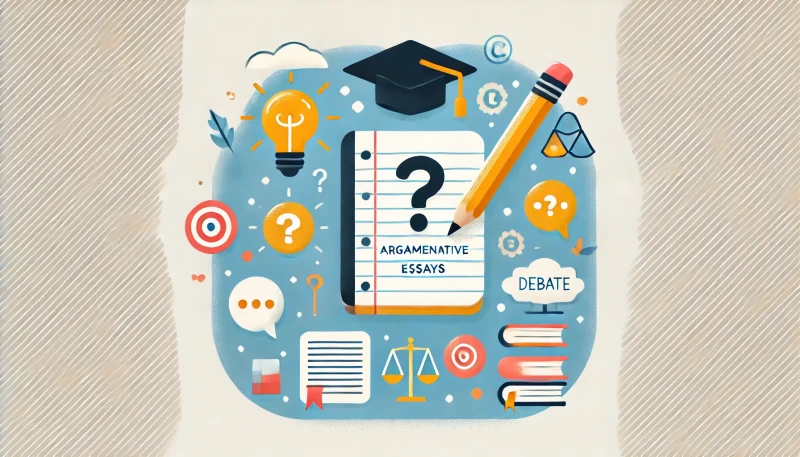Unlock Insights: Find the Answers You Seek on Our Blog
What is an Issue Statement in an Argumentative Essay and How to Write One
By Evelyn Sterling
Welcome to the Ultimate Guide to Issue Statements in Argumentative Essays!
This resource is designed to help you master the art of crafting effective issue statements, a critical component of any persuasive essay. Whether you’re a student aiming to sharpen your writing skills or an educator looking for clear examples to share, understanding issue statements is key to creating focused and impactful arguments.
Here, you’ll find everything you need to know about issue statements, including their definition, purpose, and step-by-step guidance for writing your own. With practical tips, common mistakes to avoid, and examples to inspire you, this guide will make the process simple and approachable. Let’s dive in and learn how to start your argumentative essays on the right foot!
What is an Issue Statement?
An issue statement in an argumentative essay is a sentence or two that clearly introduces the topic of debate. It lays out the problem or question you will address in your essay without taking a side. The purpose is to present the issue in a way that invites discussion and shows why it’s important to consider.
It’s easy to confuse an issue statement with a thesis statement, but they are not the same. An issue statement explains what the essay will discuss—essentially framing the topic or problem. On the other hand, a thesis statement explains how you will argue your position. For example:
- Issue Statement: “Should social media platforms be regulated to protect users’ privacy?”
- Thesis Statement: “Social media platforms should be regulated by stricter laws to ensure user privacy and prevent misuse of personal data.”
A common misconception is that an issue statement needs to argue your point of view. However, the issue statement is neutral—it introduces the topic, not your stance. Another mistake is making it too broad or vague, which can confuse readers. A good issue statement is clear, concise, and sets up the essay for a strong argument.

Purpose of an Issue Statement
The main purpose of an issue statement is to introduce the central topic of debate in your essay. It helps the reader understand what the essay will be about and sets the stage for your argument. Without a clear issue statement, the essay might feel scattered or unclear, making it harder for readers to follow your ideas.
An issue statement also provides a clear focus for the essay. By narrowing down the topic to a specific question or problem, it ensures that your argument stays on track. This focus is crucial because it keeps your writing organized and prevents you from drifting into unrelated topics.
Finally, an issue statement guides readers toward understanding why the topic is important. It shows them why the issue matters and how it affects the bigger picture. For example, if you’re writing about environmental policies, your issue statement can highlight the urgency of addressing climate change. This gives readers a reason to care about your argument and stay engaged with your essay.
In short, an issue statement is like a roadmap. It tells readers what to expect, keeps your writing focused, and helps them see the importance of the topic you’re discussing.
Characteristics of a Strong Issue Statement
A strong issue statement has three key characteristics: clarity, relevance, and conciseness. These qualities ensure that your issue statement effectively introduces the topic and grabs the reader’s attention.
Clarity is essential because your issue statement needs to be easy to understand. Avoid using vague or confusing language that might leave readers unsure about your topic. Instead, use simple and direct phrasing to clearly state the issue. For example, instead of saying, “Social media has problems,” you could say, “Should social media platforms be held accountable for spreading misinformation?”
Relevance is about connecting the issue to something that matters to your audience. Choose topics that are current, significant, or directly impact readers. For instance, discussing the ethical use of AI in education is a relevant topic today because it’s a growing concern for students and educators alike.
Conciseness means keeping your issue statement short and to the point. Avoid adding unnecessary details or going off-topic. A strong issue statement introduces the topic in just one or two sentences. For example, “Is universal healthcare the solution to rising medical costs?” is concise and sets up the discussion without extra fluff.
By focusing on clarity, relevance, and conciseness, you can create an issue statement that is both engaging and effective, setting the tone for a compelling argumentative essay.

How to Write an Effective Issue Statement
Writing an effective issue statement doesn’t have to be complicated. Follow these four simple steps to create a statement that sets the stage for a strong argumentative essay.
Step 1: Identify the central question or controversy.
Start by asking yourself, “What is the main question I want to explore?” Your issue statement should focus on a specific problem or debate. For example, instead of saying, “Education is important,” you could ask, “Should college education be free for all students?” This makes the topic clear and engaging.
Step 2: Research and narrow down the focus.
Once you have a general idea, research the topic to understand different perspectives. This will help you refine the issue statement to be specific and manageable. For example, instead of discussing “climate change” broadly, you could focus on, “What role should governments play in reducing carbon emissions?”
Step 3: Use neutral and objective language.
An issue statement should not show bias or take a side. Its purpose is to introduce the topic, not argue your position. For instance, say, “Does social media negatively impact mental health?” rather than, “Social media is ruining people’s mental health.” Neutral phrasing invites discussion and keeps the focus on the issue.
Step 4: Align the issue statement with your thesis and argument structure.
Make sure your issue statement leads naturally into your thesis statement. The issue introduces the topic, and the thesis explains your position. For example, if your issue is, “Should schools ban junk food?” your thesis might argue, “Schools should ban junk food to promote healthier eating habits.”
By following these steps, you can craft an issue statement that is clear, focused, and sets the foundation for a compelling argument.
Issue Statement Examples
Here are three examples of issue statements to show you how they introduce topics clearly and set the stage for a strong argumentative essay.
Example 1: “Should college education be free for all?”
This issue statement introduces the debate about whether higher education should be accessible to everyone without cost. It frames the topic as a question, inviting readers to think about the pros and cons of free college. This statement is clear, relevant, and focuses on a widely discussed issue.
Example 2: “Is social media harming mental health?”
This statement raises a concern that affects millions of people today. It introduces the topic in a neutral way, leaving room to explore different perspectives. For instance, your essay could argue whether social media has more negative effects, such as anxiety and depression, or positive impacts, like fostering connections.
Example 3: “What role should government play in combating climate change?”
This statement addresses a global issue and focuses on the government’s responsibility in solving it. It opens the door to discuss various angles, such as policymaking, funding renewable energy, or regulating corporations. By narrowing the focus to the government’s role, the essay remains specific and actionable.
Each of these examples introduces a clear, focused issue that invites debate and sets up an argument. They are neutral, concise, and directly relevant to modern concerns, making them strong starting points for an essay.

Common Mistakes to Avoid
When writing an issue statement, it’s important to avoid common mistakes that can weaken your essay’s foundation. Here are three pitfalls to watch out for and how to fix them.
Mistake 1: Being too vague or broad.
An issue statement that’s too general can confuse readers and make your essay harder to follow. For example, “Education is important” is too vague because it doesn’t specify what aspect of education you’re discussing. Instead, make it more focused, like “Should college education be free for all?” This gives readers a clear idea of the debate.
Mistake 2: Including personal opinions or bias in the issue statement.
The issue statement should be neutral and objective, not an opportunity to express your opinion. For example, avoid saying, “Social media is definitely bad for mental health.” Instead, phrase it as a question: “Is social media harming mental health?” Neutral language invites discussion and keeps the focus on the issue.
Mistake 3: Misaligning the issue statement with the essay’s argument.
Your issue statement and thesis need to work together. If your issue introduces one topic but your thesis argues something unrelated, your essay will feel disorganized. For example, if your issue statement is about free college but your thesis argues for student loan forgiveness, the two don’t match. Make sure the issue statement sets up the argument you’ll make.
By avoiding these mistakes, you’ll create a strong, clear issue statement that effectively introduces your essay’s argument and engages your readers.
Tips for Refining an Issue Statement
Crafting a strong issue statement takes practice, but refining it can make your essay even better. Here are some simple tips to help you improve your issue statement.
1. Use feedback from peers or instructors.
Ask someone you trust, like a classmate or teacher, to review your issue statement. They can help you spot unclear language or identify areas where your statement might need more focus. Sometimes, a fresh perspective can reveal problems you might not notice on your own.
2. Read other argumentative essays for inspiration.
Look at examples of well-written essays to see how others frame their issue statements. Pay attention to how they introduce their topics and stay focused on the debate. This can give you ideas on how to structure your own statement and ensure it’s engaging and relevant.
3. Test the statement by formulating counterarguments.
A strong issue statement should naturally invite debate. Once you’ve written your statement, try coming up with counterarguments. For example, if your issue is, “Should social media platforms be regulated to prevent misinformation?” think of arguments both for and against regulation. If the statement makes it easy to explore different sides, it’s likely clear and effective.
By using these tips, you can refine your issue statement into a strong, focused introduction that sets the stage for a compelling argument. Remember, practice and feedback are key to improvement!
Conclusion
A well-crafted issue statement is essential for a strong argumentative essay. It introduces the central topic, provides focus, and engages readers by highlighting the relevance of the debate.
By practicing and refining your skills, you can master the art of writing clear and effective issue statements that set the foundation for persuasive arguments. Use feedback, examples, and counterarguments to improve.
If you’re ready to take your writing further, explore related topics like crafting strong thesis statements or organizing your arguments effectively. These skills will help you create essays that are both impactful and well-structured!
AI Tools Categories
Browse all AI tools by category
All AI Tools
229Amazon
5AI Writing Generator
85Article & Content Writing
35Branding & Identity
54Content Generation
170Creative Ideas
32Educational Resources
34E-commerce
14Etsy
6Events & Celebrations
13Facebook
6Gaming & Fun
5Instagram
3Lifestyle & Personal
8LinkedIn
6Marketing & SEO
40Poem & Lyrics Writing
19Professional Documents
31Social Media
44Story & Book Writing
49Text Effects
14TikTok
7Twitter
3Writing Enhancement
36YouTube
11
Highly rated and most popular AI tools curated by our experts
Recently added AI tools that are gaining traction
- AI Post Generator

- AI Bullet Point Generator

- AI Discussion Post Generator

- AI 2 Weeks Notice Letter Generator

- AI Content Creation Ideas Generator

- AI Radio Ad Script Generator

- AI Podcast Script Generator

- AI Resume Objective Generator

- AI Resume Headline Generator

- AI Password Generator

- AI Snapchat Caption Generator

- AI Snapchat Username Generator

- AI Pinterest Board Name Generator

- AI LinkedIn Experience Description Generator

- AI Twitter Hashtag Generator

- AI YouTube Short Idea Generator

we prioritize displaying the latest content closely related to the current blog post.







